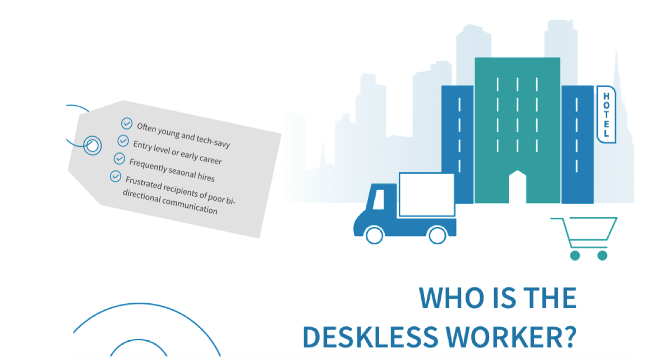The Coming Technology Transformation of the Deskless Workforce

If you’ve recently watched a store employee updating merchandise or seen a new crew-member in training at a quick service restaurant, you may have noticed the tasks being performed with clipboards, binders, or paper instructions. To someone outside the service world, these old-school methodologies are a striking throwback to how work was conducted fifteen or twenty years ago, especially given the omnipresent nature of mobile devices these days.
Why are these deskless workers not beneficiaries of new technologies? What challenges do they face today, and what benefits could businesses experience if deskless workers were empowered with technology on the job?

Deskless Worker Challenges
Deskless workers are usually young, tech-savvy, and performing entry-level jobs where they have high turnover rates. Due to poor bi-directional communication between management and employees, they often feel unheard, under-appreciated, and lack context for how their job impacts the overall success of the business.
Three major challenges face deskless workers, the first of which is finding and utilizing the content needed to do their jobs. In fact, 76% of employees complain about the difficulty of finding accurate and needed information, which is not surprising given a commissioned study conducted by Forrester Consulting on behalf of Inkling which states:
“Over two-thirds [of businesses] indicate that content in their organization is not in a format that helps them in their moment of need—a must have for deskless workers. Indeed, continuing to under-serve this significant portion of the workforce will result in reduced employee productivity and satisfaction—ultimately hindering the business’s ability to win, serve, and retain customers.”
That Forrester finding leads nicely into the second challenge, which is employee engagement. Gallup survey results report that businesses experience 65% lower turnover when employees are engaged and empowered with knowledge. Unfortunately, engaged employees account for just 30% of the American workforce today, and deskless workers are known specifically for their high turnover rates due to the nature of the work. This scenario is expensive for companies, as the average cost to replace a worker who earns less than $30,000 per year is approximately 16% of that person’s annual salary.
Finally, deskless workers spend a large portion of time working directly with customers, and 89% of companies expect to compete primarily on the basis of the customer experience. However, as Gartner reports, poor customer service and inconsistent field execution occur when employees are disengaged, frustrated, and lack communication methods. Coupled with a potential 20% loss of annual revenue occurs when positive and consistent customer experiences are not provided, many companies are stuck trying to figure out how to engage and communicate with their deskless workforce.
The Mobile Answer
To address the challenges of the deskless workforce, corporations are starting to focus their efforts on empowering these employees. The biggest question many businesses face is what technology to adopt that will enable workers to utilize information and achieve greater consistency. Coupled with enabling employees is the need for enterprises to gather data that measures the quality of execution in the field.
With the decrease in device costs, improvements in connectivity and security, and the rapid increase in capabilities, mobile represents the ideal answer to these challenges. In fact, 89% of retailers plan to deploy associate-level mobile programs within the next three years; to date, only 13% have implemented programs that they believe are working well, according to Boston Retail Partners.
To achieve success, a holistic mobile solution is needed that provides:
- Accurate and up-to-date content
- Messaging and real-time communications
- Task management and tracking
- Compliance with standardized operations and regulations
- Data and analytics for visibility
When deskless workers are equipped with easy-to-use mobile-first tools that provide access to real-time communications and mission-critical reference and training content, field workers will achieve greater operational consistency, and operations professionals will achieve data-driven insights into what’s working. This combination of improved execution and heightened visibility will drive greater strategic agility in the enterprise.
The outcomes when these mobile capabilities are provided to deskless workers are startling. Forrester data shows that decision-makers credit digitized, interactive, and mobile-friendly content with a 36% increase in paper savings, 26% increase in employee productivity, and a 31% increase in better customer experiences.
The financial results are equally impressive, as Northwestern University research concluded that 10% more effort from a salesperson is correlated to 22.7% higher spend by customers. Gallup survey results further demonstrate the point: businesses with engaged employees experience 22% higher profitability and 21% higher productivity.
In Conclusion
The operational results that companies crave and the exceptional experiences that make customers loyal are both possible when deskless workers are empowered and engaged.
Businesses that modernize their field operations today with a mobile workforce enablement solution will benefit from increases in operational excellence, improved employee and customer satisfaction, better employee acquisition and retention, and positive financial results that boost the bottom line.
If you’re ready to evaluate the opportunity and rethink your operations, Inkling is ready to help you succeed. Register today for a product demo.
